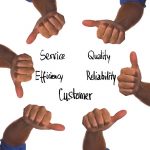Industry Talk
Regular Industry Development Updates, Opinions and Talking Points relating to Manufacturing, the Supply Chain and Logistics.The Key to Navigating Supplier Relationships in the Post-Pandemic World

Nearly a year and a half ago, day-to-day life was turned on its head as mandatory work-from-home and no-travel policies were implemented to combat the COVID-19 pandemic. In only a number of months, this sudden change sped up the adoption of digital technologies and supplier relationships by several years. The resulting corporate learning curve was steep and challenging for professionals everywhere, and those in supply chain management were no exception; in fact, they were some of the most affected.
During this time, leaning more heavily on existing, but often underutilized, tech solutions like video conferencing software and digital collaboration tools like e-sourcing was pivotal for many organizations to survive. But as we look forward, it’s surprising to see that some enterprises are hoping to go back to the way things were before.
But the truth is, COVID simply accelerated the inevitable adoption of these new technologies, and there is no going back. If you’re finding yourself struggling with this transition, the following guide should help provide some peace of mind—as well as some tips to move forward.
What’s Accounting for the Pushback?
The opposition against remote relationships and interactions is founded on numerous concerns. First, there’s the misconception that remote-only environments foster delays and obstacles in sourcing and procurement activities. The foreign nature of distanced collaboration, bidding, and negotiations has created hold-ups in productivity, as executives work to familiarize themselves with new processes and adopt technologies they are not yet comfortable with.
Some struggle with the power balance of purely remote supplier relationships. The typical communication methods were disrupted by the pandemic, with face-to-face work drastically reduced or abolished. The vast spectrum of collaboration and negotiation options previously available to sourcing teams—the art of the trade if you like—was quickly reduced to a set of structured formal steps.
While the scheduled portion of a face-to-face meeting can quite easily be substituted with an online equivalent, there is a more valid concern around missing out on the time spent with stakeholders outside of the meeting itself (e.g. while walking to and from the venue, or grabbing a coffee afterward). This left many buyers feeling as though they lost their footing and control over the negotiation process.
What You Can Do to Succeed
For those organizations struggling to regulate negotiations in a remote environment, now is the time to lean into the available technologies to make the process more manageable.
Collaboration platforms, for example, are frequently used by supply management teams to find suppliers and acquire their capability and pricing information. In this case, they can engage and negotiate with multiple vendors simultaneously in real-time to obtain a contract and secure products or services.
The technology has a transformative effect, streamlining the process of identifying and negotiating with suppliers, as well as leveling the playing field for vendors bidding on contracts by eliminating human biases from the sourcing equation. However, while a powerful collaboration platform can provide speed and structure to this otherwise complex process, it doesn’t answer the questions of who you should collaborate with or which negotiation levers to utilize to optimize the outcome.
Without this information, although your organization’s process may be fast-tracked, it won’t necessarily be inherently intentional or calculated. To achieve true agility, effectiveness, and success, you need access to both mechanics and insights. For this reason, you should opt for full-suite platforms that also offer reliable strategies and community data to support successful negotiations.
Full-suite collaboration platforms that provide specific recommendations based on real-time data and community insights, together with built-in quote, bid, and award tools, streamline the process in more ways than one. First, they provide the holistic overview needed to handle negotiations with a fully informed perspective and understanding of your starting point compared to the market. They also allow for a virtual meeting ground between you and your suppliers outside scheduled conference or video calls. This ensures collaborative efforts are not limited to scheduled meetings; it also means that those same meetings will be more straightforward, focused, and effective.
Moving Forward
There’s no denying that life after COVID will likely contain remnants of “what was.” But as we move forward, the most successful organizations will undoubtedly be those that remain adaptable and open to digital supplier relationships. Embracing the processes and tools available to us now may take some time, but it’s an effort that will be well worth it.










